
Business Management
OUR COURSES
Pizza Classica - Classic Pizza
Course Certificates
PIZZA CHEF CERTIFICATE
CLASSIC PIZZA CERTIFICATE
Course Contents
– Theory on Pizza and Flours
– Differences between “Pizza Classica” and “Pizza Napoletana”
– Mixing, Spreading and Toppings
– Cooking in the Electric Oven
– Management and Storage of Ingredients
– Management and Storage of Dough
– Maturation and Leavening of Dough
– Use of Specific Equipment
Pizza Contemporanea - Contemporary Pizza
Course Certificates
CONTEMPORARY PIZZA CERTIFICATE
Course Contents
– Direct and Indirect Dough
– Management and Storage of Dough
– High Hydration Dough
– Pre-dough: Biga, Poolish and Gel
– Different Types of Flour
– Mix Seeds and Cereal Flour
– Natural Ingredients to Colour the Dough
Pizza al Taglio - Square Pizza
Course Certificates
SHOVEL PIZZA CERTIFICATE
TRAYBAKE PIZZA CERTIFICATE
Course Contents
– Pizza on the Shovel “Pizza in Pala”
– Pizza on Baking Tray “Pizza in Teglia”
– Large Pizza to Be Sold as a Slice
– Mixing, Spreading and Toppings
– Cooking in the Electric Oven
– Management and Storage of Dough
– Use of Specific Equipment
– Retail Sales of Slices
– Stuffed Pizza “Pizza Farcita”
– Folded Pizza “Calzone”
Pizza Vegana - Vegan Pizza
Course Certificates
VEGAN PIZZA CERTIFICATE
Course Contents
– Management and Storage of Vegan Ingredients
– Vegan Toppings
– Filled Vegan Pizza
– Presentation of Vegan Pizza
Pizza Dessert - Dessert Pizza
Course Certificates
DESSERT PIZZA CERTIFICATE
Course Contents
– Management and Storage of Sweet Ingredients
– Sweet Toppings
– Filled Dessert Pizza
– Presentation of Sweet Pizza
Pizza Gourmet - Gourmet Pizza
Course Certificates
GOURMET PIZZA CERTIFICATE
Course Contents
– Management and Storage of Gourmet Ingredients
– Gourmet Toppings
– Filled Gourmet Pizza
– Presentation of Gourmet Pizza
– Special Dough
– Double Leavening
– Spreading and Cooking
Pizza al Padellino - Pan Pizza
Course Certificates
PAN PIZZA CERTIFICATE
Course Contents
– Pizza on the Pan “Pizza al Padellino”
– Management and Storage of Ingredients
– Gourmet Toppings
– Filled Pizza on the Pan
– Presentation of Pizza on the Pan
– Special Dough
– Double Leavening
– Spreading and Cooking
OUR DOUGHS
This type of dough takes the name from its particular manufacturing process which involves two or more processing stages at different times.
At first, a pre-dough is made, which is left to ferment either at room temperature or controlled temperature for several hours before refreshing for the final dough.
We usually use a “Biga” or a “Poolish”, sourdough or a carry-over mass with will act as yeast for the final dough.
This method is used for several reasons, both technical and practical: to facilitate the absorption of high hydration in the dough, enhance the taste, friability and digestibility.
However, this type of dough, needs careful management in the various processing stages, respecting times and temperatures and using the right ingredients in the right percentages, to avoid excessive maturation which can then negatively affect the final product.
When the dough is created entirely in the same processing phase, it’s called “direct dough”, and does not require the use of any pre-dough process.
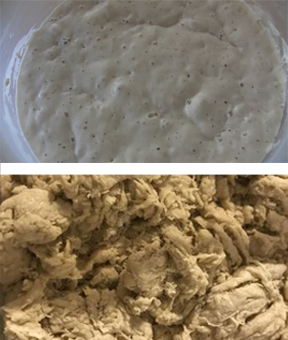
This dough is made exclusively with type “00” flour, the most classic and popular flour in the world.
This flour, precisely because of its refining, has a high carbohydrate content and low fibre, it is dehydrated and deprived of the bran of the soft wheat grain.
Lacking devoid of all the bran parts of the grain of wheat, it has a flat white colour.
It is also used in pastry and catering, due to its ability and flexibility of work.
Type “00” flour is still the most used in all pizzerias in the world and when we think of pizza, whatever type it is, we associate the flavour to this type of flour that is the basis of all our daily pizzas, both professional and domestic.

This dough is made with the usual exclusive “type 1” flour, or stone-ground as it was done in the past, or even with the use of metal rollers.
It can also be created by mixing the various flours in different percentages, using either “wholewheat” flour or “type 2” flour, mixed with flour “0” or “00”.
This “type 1” solution is used, which is the best semi-wholewheat flour, to be able to have a dough that preserves the nutritional and organoleptic characteristics of the grain itself and to have good fibre content and an intense taste.
This solution is widely used in recent times to (dirty) the dough made with “00” flour, due to adding a bigger part of fibre to improve the digestibility and the taste of the final product.
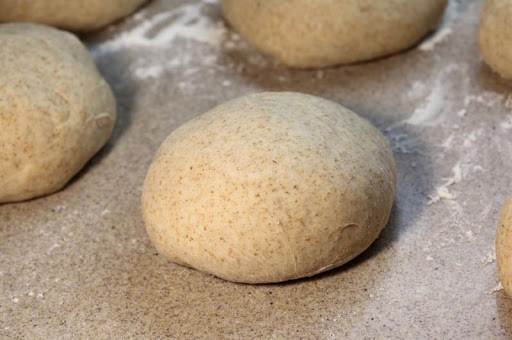
This dough is created exclusively with the use of “wholewheat” flour.
The wholewheat flour is divided into two types, fine grain and coarse grain, but in both cases, it contains all the components of the grain kernel, in fact, it’s milled from the complete seed and nothing is removed.
It’s only crushed to be transformed into flour.
It is a nutritional mixture very rich in fibre, minerals and vitamins, as most of the whole grain products, particularly suitable for vegans or vegetarians, as well as for a healthy diet.
The flavour has a strong kick, in which the fundamental parts of the grain are well present and have a darker almost brown colour.
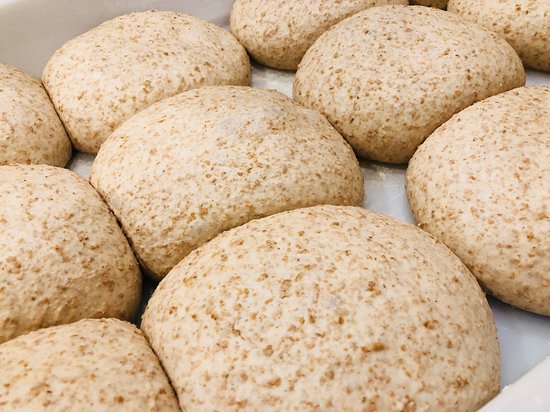
This dough is created by adding a percentage of single or mixed seeds to the ingredients of the dough, such as chia seeds, flax seeds, poppy seeds, amaranth seeds, sesame seeds, quinoa seeds etc. …
or using some cereals such as barley, chickpeas, spelt, rice, oats, rye, hemp and many others.
We can also use seeds and cereals at the same time, to create personalized doughs and to be able to combine particular ingredients during the seasoning phase.
In this way, we can obtain doughs with different colours and flavours, however adding healthy and nutritional ingredients.
These seeds and cereals can also be used whole and organic.
Another technique that is used is to toast the seeds and leave them for a few hours in the water that will be used for the dough, in order to flavour the final dough.
These methods can be combined with any type of dough, both direct and indirect.
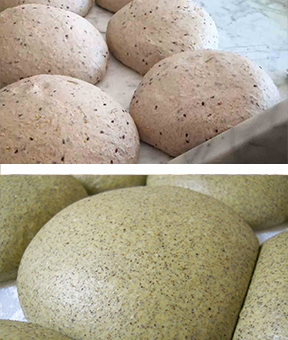
These special doughs are created by combining a natural coloured ingredient with all the other ingredients during the mixing phase.
The ingredients for colouring the dough can be processed or used as they are, therefore using them with their different consistencies, such as in powder, liquid or solid form.
Among the various types of colouring ingredients, which we are going to add as a percentage to our dough, we can find wine, coffee, saffron, turmeric, beetroot, spinach, purple potatoes, and many others.
In this way, we can obtain doughs with different colours and flavours, adding healthy and nutritional ingredients.
This dough can also be used in combination with the various seeds, so as to offer a product that is also nutritional and healthy.
This technique can be combined with any type of dough, both direct and indirect
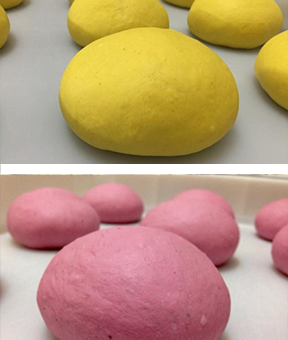
This dough is used for pizzas such as “Pizza in Pala”, “Pizza in Teglia”, “Pizza Gourmet” and “Pizza al Padellino”.
Lately, this technique is often combined with the use of indirect doughs on “Pizza Classica” and on “Pizza Napoletana”, taking the name of Contemporary Pizza, obtaining increasingly pronounced and puffy pizza crust.
This technique, as the name implies, involves the use of a high water content in the dough, which creates a more moist and sticky dough, resulting in an airy honeycomb section inside the pizza which is easily digestible, combining friability and crunchiness with a soft and light end product.
It has a completely different method from all the other doughs, regardless of the flours used, which however must be suitable for this specific technique.
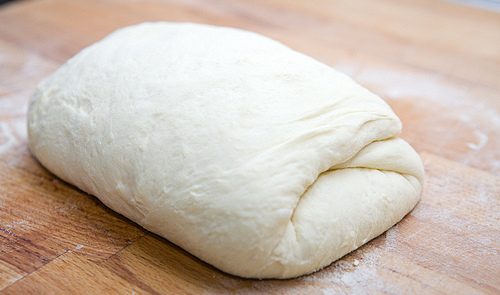
REQUEST A FREE QUOTE
Our new pizza school with the pizza equipment showroom will be ready in the coming months in Cramlington.
Follow us for the next updates on the Pizza chef courses and our news.



